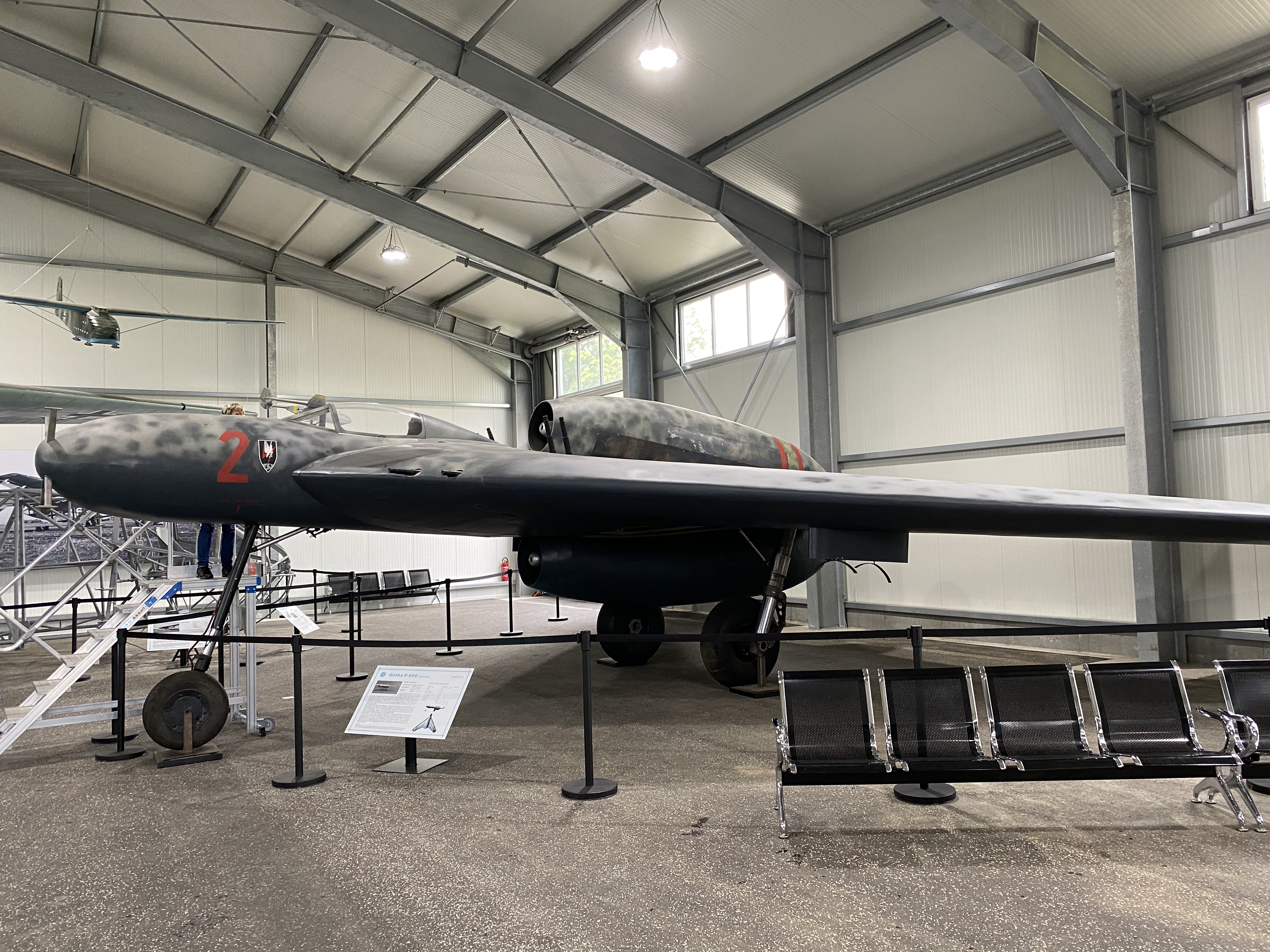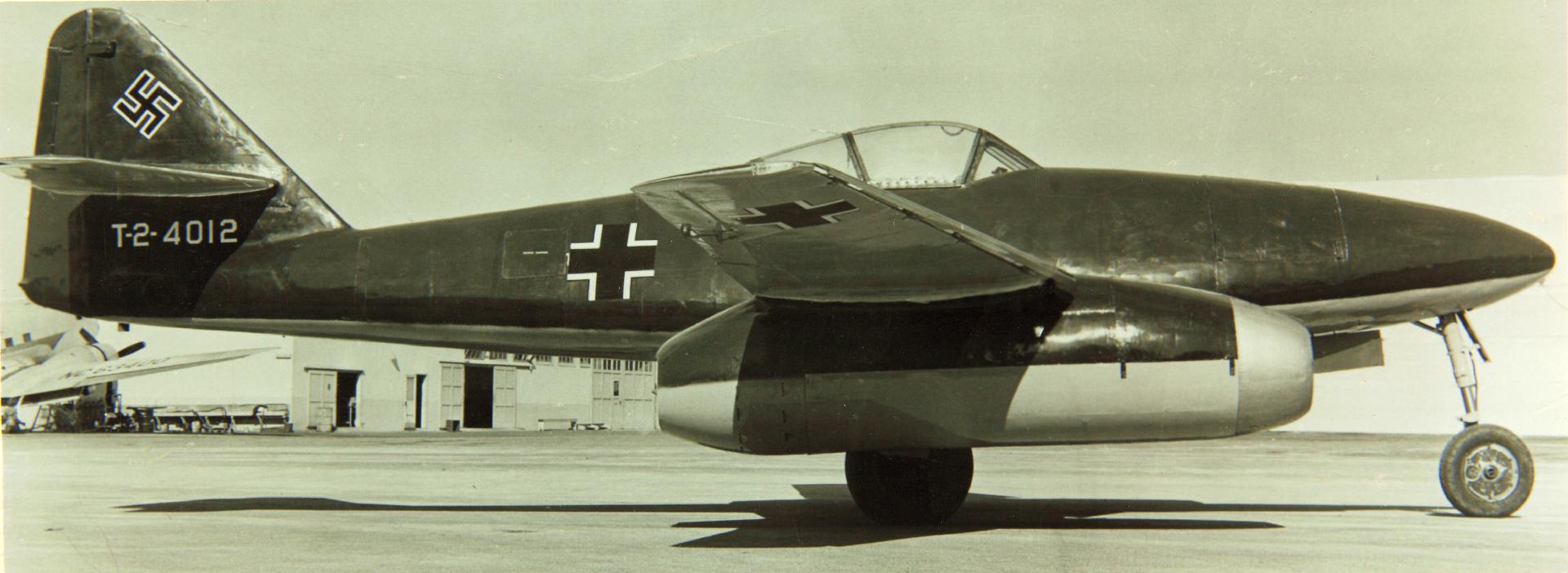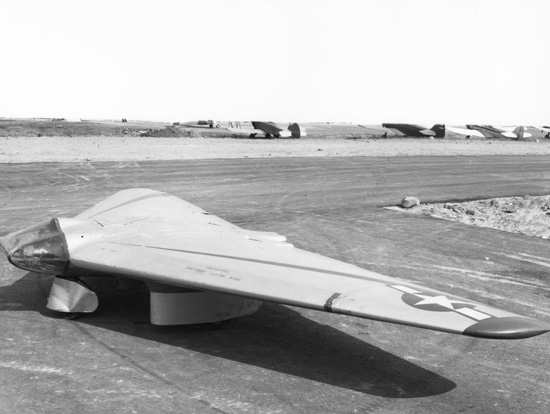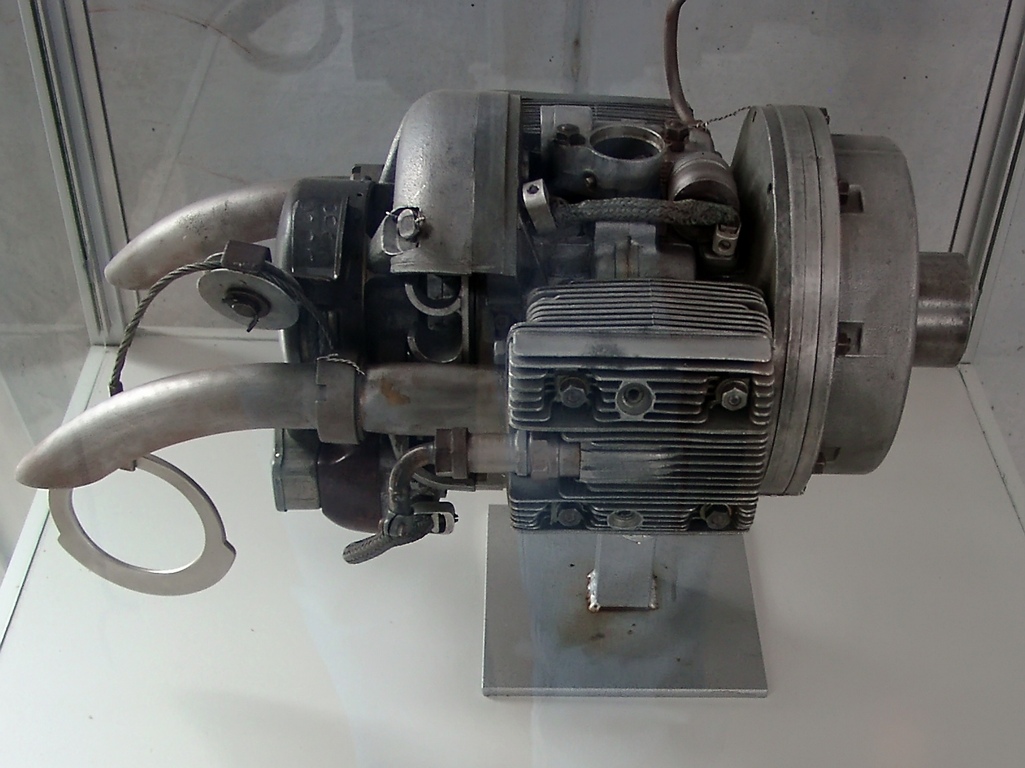|
Gotha Go P.60
The Gotha Go P.60 was a jet-powered flying wing fighter proposed during World War II by Gothaer Waggonfabrik (Gotha). It was conceived as an improved derivative of the single-seat Horten Ho 229, which Gotha had begun to manufacture as the Go 229. The initial concept a two-seat multi-role fighter that was subsequently developed into a three-seat night and all-weather fighter, but no variant was ever built. Design and development The company proposed the Go P.60A in January 1945, retaining many of the same principles of construction as the Horten design, but mounted the engines in external nacelles and totally revised the cockpit layout. The Go P.60A was to have two BMW 003A-1 turbojet engines, mounted above and below the wing. This arrangement was chosen for ease of maintenance as well as to simplify the process of installing other engines, although it severely compromised the ability of the pilots to bail out of the fighter. Fully faired into the leading edge of the fuselage, ... [...More Info...] [...Related Items...] OR: [Wikipedia] [Google] [Baidu] |
Fighter Aircraft
Fighter aircraft are fixed-wing military aircraft designed primarily for air-to-air combat. In military conflict, the role of fighter aircraft is to establish air superiority of the battlespace. Domination of the airspace above a battlefield permits bombers and attack aircraft to engage in tactical and strategic bombing of enemy targets. The key performance features of a fighter include not only its firepower but also its high speed and maneuverability relative to the target aircraft. The success or failure of a combatant's efforts to gain air superiority hinges on several factors including the skill of its pilots, the tactical soundness of its doctrine for deploying its fighters, and the numbers and performance of those fighters. Many modern fighter aircraft also have secondary capabilities such as ground attack and some types, such as fighter-bombers, are designed from the outset for dual roles. Other fighter designs are highly specialized while still filling the ma ... [...More Info...] [...Related Items...] OR: [Wikipedia] [Google] [Baidu] |
Rudder
A rudder is a primary control surface used to steer a ship, boat, submarine, hovercraft, aircraft, or other vehicle that moves through a fluid medium (generally aircraft, air or watercraft, water). On an aircraft the rudder is used primarily to counter adverse yaw and p-factor and is not the primary control used to turn the airplane. A rudder operates by redirecting the fluid past the hull (watercraft), hull or fuselage, thus imparting a turning or yaw (rotation), yawing motion to the craft. In basic form, a rudder is a flat plane or sheet of material attached with hinges to the craft's stern, tail, or after end. Often rudders are shaped so as to minimize Drag (physics), hydrodynamic or aerodynamic drag. On simple watercraft, a tiller—essentially, a stick or pole acting as a lever arm—may be attached to the top of the rudder to allow it to be turned by a helmsman. In larger vessels, cables, pushrods, or hydraulics may be used to link rudders to steering wheels. In typical air ... [...More Info...] [...Related Items...] OR: [Wikipedia] [Google] [Baidu] |
List Of Jet Aircraft Of World War II
World War II was the first war in which jet aircraft participated in combat with examples being used on both sides of the conflict during the latter stages of the war. The first successful jet aircraft, the Heinkel He 178, flew only five days before the 1 September 1939 start of the war. By the end of the conflict on 2 September 1945 Germany, the United Kingdom, and the United States all had operational turbojet-powered fighter aircraft while Japan had produced, but not used, motorjet-powered kamikaze aircraft, and had tested and ordered into production conventional jets. Italy and the Soviet Union had both tested motorjet aircraft which had turbines powered by piston engines and the latter had also equipped several types of conventional piston-powered fighter aircraft with auxiliary ramjet engines for testing purposes. Germany was the only country to use jet-powered bombers operationally during the war. This list includes only aircraft powered by turbine engines, either on their o ... [...More Info...] [...Related Items...] OR: [Wikipedia] [Google] [Baidu] |
List Of Aircraft Of World War II
A ''list'' is any set of items in a row. List or lists may also refer to: People * List (surname) Organizations * List College, an undergraduate division of the Jewish Theological Seminary of America * SC Germania List, German rugby union club Other uses * Angle of list, the leaning to either port or starboard of a ship * List (information), an ordered collection of pieces of information ** List (abstract data type) In computer science, a list or sequence is an abstract data type that represents a finite number of ordered values, where the same value may occur more than once. An instance of a list is a computer representation of the mathematical concept of a ..., a method to organize data in computer science * List on Sylt, previously called List, the northernmost village in Germany, on the island of Sylt * ''List'', an alternative term for ''roll'' in flight dynamics * To ''list'' a building, etc., in the UK it means to designate it a listed building that may not be a ... [...More Info...] [...Related Items...] OR: [Wikipedia] [Google] [Baidu] |
Northrop XP-79
The Northrop XP-79, USAAF project number MX-365, was an ambitious design for a flying wing fighter aircraft, designed by Northrop. It had several notable design features; among these, the pilot would operate the aircraft from a lying position, permitting the pilot to withstand much greater ''g''-forces in the upward and downward direction with respect to the plane – and welded magnesium monocoque structure instead of riveted aluminum. Design and development In 1942, John K. (Jack) Northrop conceived the XP-79 as a high-speed rocket-powered flying-wing fighter aircraft. In January 1943, a contract for two prototypes (s/n 43-52437 & 43-52438) with designation XP-79 was issued by the United States Army Air Forces (USAAF). Originally, it was planned to use a thrust XCALR-2000A-1 "rotojet" rocket motor from Aerojet that used mono-ethylaniline fuel and red fuming nitric acid (RFNA) oxidiser. However, the rocket motor configuration using canted rockets to drive the turbo ... [...More Info...] [...Related Items...] OR: [Wikipedia] [Google] [Baidu] |
RB 50/18
Rb or RB may stand for: Arts and entertainment * Rebecca Black, an American pop singer * Richard Blackwood, a British rapper * Rhythm and blues, a music genre combining blues, gospel and jazz influences * ''Rock Band'', a music video game series * ''Rock Band'' (video game), the game of the same name *''Ultraman R/B'', a Japanese television series Businesses * Rankin/Bass, an American production company, known for its seasonal television specials * Ray-Ban, a sunglasses company * Reckitt Benckiser, a company in the United Kingdom * Syrian Arab Airlines (IATA airline code RB) Government and politics * Radio Bremen, a public broadcaster for the German state of Bremen * ''Parti de la Renaissance du Bénin'' or Benin Rebirth Party, a political party in Benin * República Bolivariana, Spanish-language phrase for the type of government in Venezuela * Rupiah Banda, President of Zambia Science and technology * .rb, the file extension for documents created in Ruby or in REAL Basic * ... [...More Info...] [...Related Items...] OR: [Wikipedia] [Google] [Baidu] |
Gotha P-60C
Gotha () is the fifth-largest city in Thuringia, Germany, west of Erfurt and east of Eisenach with a population of 44,000. The city is the capital of the district of Gotha and was also a residence of the Ernestine Wettins from 1640 until the end of monarchy in Germany in 1918. The House of Saxe-Coburg and Gotha originating here spawned many European rulers, including the royal houses of the United Kingdom, Belgium, Portugal (until 1910) and Bulgaria (until 1946). In the Middle Ages, Gotha was a rich trading town on the trade route ''Via Regia'' and between 1650 and 1850, Gotha saw a cultural heyday as a centre of sciences and arts, fostered by the dukes of Saxe-Gotha. The first duke, Ernest the Pious, was famous for his wise rule. In the 18th century, the ''Almanach de Gotha'' was first published in the city. The publisher Justus Perthes and the encyclopedist Joseph Meyer made Gotha a leading centre of German publishing around 1800. In the early 19th century, Gotha was a bi ... [...More Info...] [...Related Items...] OR: [Wikipedia] [Google] [Baidu] |
Walther 109-508
Walther is a masculine given name and a surname. It is a German form of Walter, which is derived from the Old High German ''Walthari'', containing the elements ''wald'' -"power", "brightness" or "forest" and ''hari'' -"warrior". The name was first popularized by the famous epic German hero Walther von Aquitaine and later with the Minnesänger Walther von der Vogelweide. Given name * Walther Bauersfeld (1879–1959), German engineer who built the first projection planetarium * Walther Bothe (1891–1957), German nuclear physicist and Nobel laureate * Walther von Brauchitsch (1881–1948), German World War II field marshal * Walther Dahl (1916–1985), German World War II flying ace * Walther von Dyck (1856–1934), German mathematician * Walther Flemming (1843–1905), German biologist and a founder of cytogenetics * Walther Funk (1890–1960), economist and Nazi official convicted of war crimes in the Nuremberg Trials * Walther Hahm (1894–1951), German World War II general * Wa ... [...More Info...] [...Related Items...] OR: [Wikipedia] [Google] [Baidu] |
Victory In Europe Day
Victory in Europe Day is the day celebrating the formal acceptance by the Allies of World War II of Germany's unconditional surrender of its armed forces on Tuesday, 8 May 1945, marking the official end of World War II in Europe in the Eastern Front, with the last shots fired on the 11th. Russia and some former Soviet countries celebrate on 9 May. Several countries observe public holidays on the day each year, also called Victory Over Fascism Day, Liberation Day or Victory Day. In the UK it is often abbreviated to VE Day, or V-E Day in the US, a term which existed as early as September 1944, in anticipation of victory. The end of all combat actions was specified as 23:01 Central European Time, which was already 9 May in eastern Europe, and thus several former Soviet bloc countries including Russia and Belarus, as well as some former Yugoslav countries like Serbia, celebrate Victory Day on 9 May. History Adolf Hitler, the Nazi leader, had committed suicide on 30 April dur ... [...More Info...] [...Related Items...] OR: [Wikipedia] [Google] [Baidu] |
Hellmuth Walter Kommanditgesellschaft
Hellmuth Walter Kommanditgesellschaft (HWK), Helmuth Walter Werke (HWM), or commonly known as the Walter-Werke, was a German company founded by Professor Hellmuth Walter to pursue his interest in engines using hydrogen peroxide as a fuel. Having experimented with torpedoes and submarines, Walter began to design rocket engines for aircraft and founded the HWK in Kiel in 1935. During World War II the HWK developed and built a variety of rocket engines for assisted take-off (RATO), and guided missiles, before developing main propulsion engines for rocket-powered interceptor aircraft, notably the Messerschmitt Me 163 ''Komet'' and the Bachem Ba 349 ''Natter''. HWM designed the steam catapult that launched the V-1 flying bomb. The steam was generated through the combination of T-Stoff and Z-Stoff. The company was wound up in 1945 and Walter subsequently continued his work in the United States. See also * C-Stoff – another chemical fuel developed by HWK * Walter HWK 109-500 – RA ... [...More Info...] [...Related Items...] OR: [Wikipedia] [Google] [Baidu] |
Heinkel HeS 011
The Heinkel HeS 011 or Heinkel-Hirth 109-011 ''(HeS - Heinkel Strahltriebwerke)'' was an advanced World War II jet engine built by Heinkel-Hirth. It featured a unique compressor arrangement, starting with a low-compression impeller in the intake, followed by a "diagonal" stage similar to a centrifugal compressor, and then a three-stage axial compressor. Many of the German jet-powered aircraft designs at the end of the war were designed to use the HeS 011, but the HeS 011 engine was not ready for production before the war ended in Europe and only small numbers of prototypes were produced. Design and development Starting in 1936, Junkers started a jet engine development project under the direction of Wagner and Müller, who worked on axial compressor designs. By 1940 they had progressed to the point of having a semi-working prototype, which could not run under its own power and required an external supply of compressed air. Meanwhile, Hans Mauch, in charge of engine developme ... [...More Info...] [...Related Items...] OR: [Wikipedia] [Google] [Baidu] |
Ministry Of Aviation (Nazi Germany)
The Ministry of Aviation (german: Reichsluftfahrtministerium, abbreviated RLM) was a government department during the period of Nazi Germany (1933–45). It is also the original name of the Detlev-Rohwedder-Haus building on the Wilhelmstrasse in central Berlin, Germany, which today houses the German Finance Ministry (german: Bundesministerium der Finanzen). The Ministry was in charge of development and production of all aircraft developed, designed and built in Germany during the existence of the Third Reich, overseeing all matters concerning both military and civilian designs – it handled military aviation matters as its top priority, particularly for the Luftwaffe. As was characteristic of government departments in the Nazi era, the Ministry was personality-driven and formal procedures were often ignored in favour of the whims of the Minister, ''Reichsmarschall'' Hermann Göring. As a result, early successes in aircraft development progressed only slowly and erratically dur ... [...More Info...] [...Related Items...] OR: [Wikipedia] [Google] [Baidu] |







